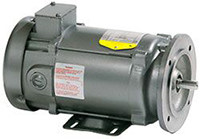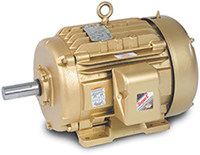Table of Contents
- What is an Electric Motor?
- Types of Electric Motors
- Hazardous Location Motors
- Electric Motor Services by Dietz Electric
Introduction
The electric motor is one of the most revolutionary inventions in recent history and has drastically changed the framework of human society. Today, electric motors are used in countless everyday objects, from appliances such as fans, refrigerators, and vacuum cleaners to vehicles, conveyor belts, and power tools.
Modern industries have become so reliant on electric motors, and it is estimated that approximately 45% of the global power usage is directed towards running electric motors in various applications. By comparison, lighting accounts for only 19% of the total global energy consumption.
This guide will explain exactly how electric motors work and describe the different types in use across industries.
What is an Electric Motor?
An electric motor is a device that converts electrical energy into mechanical energy. Put simply, motors use electricity to produce a specific motion (usually rotational). There are several types of electric motors. However, they all work based on the principle of electromagnetism. Almost all motors consist of a combination of some or all of the following essential elements:
- An armature or rotor
- Commutator
- Brushes
- Axle
- Field magnet/stator
- Power supply
The armature interacts with a magnetic field generated by a stator in the presence of current generated by an AC or DC power source to develop a mechanical torque in the axle or shaft. These elements can vary depending on the type of motor used. Some of the most common motor types include:
- AC brushless motors
- DC brushed motors
- DC brushless motors
- Direct drive
- Linear motors
- Servo motors
- Stepper motors
These motors vary in the way the conductors and the magnetic field are arranged and the input power source is used to produce the resulting motion. Other types of motors are also available; each having slightly different configurations for better suitability in different applications.
Types of Electric Motors
DC Motors
 DC motors are electric motors driven by a DC power source. These motors are available in two main variations: brushed and brushless.
DC motors are electric motors driven by a DC power source. These motors are available in two main variations: brushed and brushless.
In brushed DC motors, small carbon-based conductors, called brushes, are used to deliver charge to the commutator rings which cause the armature to rotate due to its interaction with a magnetic field. The rotation of the armature can be easily reversed by altering the polarity of the brushes. Brushed DC motors are more cost-effective and less complicated than other motors. Typical uses of brushed motors include alternators, generators, and some kitchen appliances.
In DC brushless motors, embedded electric controllers and sensors are used to alternately charge stator coils to attract and rotate a series of electromagnets. These motors were developed to occupy less space and achieve higher performance than brushed DC motors. These motors are also referred to as BLDC motors. The brushless design eliminates the possibility of brush wear, making these motors suitable for applications that require durability such as electric vehicles, cordless tools, HVAC equipment, and positioning control systems.
AC Motors
 AC Motors are driven by an AC power source. The two primary variations of AC motors are synchronous or asynchronous (induction) motors.
AC Motors are driven by an AC power source. The two primary variations of AC motors are synchronous or asynchronous (induction) motors.
Synchronous AC motors are highly precise motors that can run at a constant speed regardless of the load acting on them. The main operation of the motor is achieved by the interaction between a steady magnetic field (produced by the windings on the rotor) and a rotating magnetic field (produced by the stator); this results in overall rotational movement of the rotor. Synchronous AC motors are used in applications where accuracy is critical such as clocks, timers, robotics, metering pumps, and speed controllers.
AC brushless motors use the principle of electromagnetic induction to produce a magnetic field generated by the stator. The alternating current in the stator creates a constantly revolving electromagnetic field or a rotating magnetic field (RMF). The relative speed between the RMF and the rotor will cause a current to be induced in the rotor’s conductors, generating an electromagnetic force in accordance with Lorentz’s force law. Induction motors are one of the most common types of electric motors used today. They are used across a broad range of applications including fans, water pumps, automobiles, air conditioners, and kitchen appliances.
Other Motors
Other types of motors may fall under the general classification of AC and DC motors, including:
- Servo motors – These use feedback sensors to facilitate the positioning of components such as actuators and robotic arms.
- Stepper motor – Stepper motors use external electromagnets to electronically control an internal rotor. Differently positioned stators divide the full rotation into an equal number of steps. Stepper motors are known for their precise positioning, making them ideal for applications such as robotics, hard disk drives, and telescopes.
- Universal motors – These general purpose motors are designed to work with either DC or single phase AC power supplies. They are commonly used in railway traction mechanisms, power tools, and household appliances.
Hazardous Location Motors
Hazardous location motors are motors that are designed for safe operation in environments that contain gas, vapor, or dust that is potentially explosive or ignitable. These motors must be able to safely contain any ignitions or explosions within their housing without igniting the surrounding air.
To ensure that motors are suitable for operation in hazardous environments, they must comply with specific classes, divisions, and group classifications outlined in standards and specifications stipulated by the NFPA 70® – National Electrical Code® (NEC), and the Canadian Electrical Code (CEC).
Every motor carries a label that identifies its suitability for operating in different hazardous environments. Class I covers ignitable gases, vapors, and liquids, Class II covers electrically conductive and potentially explosive dust, and Class III covers ignitable fibers or lint, such as saw dust or textiles.
Electric Motor Services by Dietz Electric
At Dietz Electric, we offer a range of custom electric motors, drives, and power transmission systems from a variety of leading manufacturers. We draw on over four decades of experience to supply motors for many applications in any operating environment. We also specialize in modifying and repairing electric motors.
To learn more about our electric motors and how you can use them in your application, contact our technical team or request a quote today.






Comments are closed